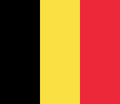| Kingdom of Belgium Koninkrijk België (Dutch) | |||||
|---|---|---|---|---|---|
| |||||
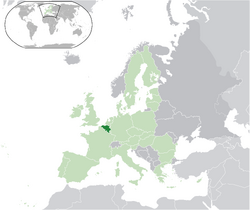
| |||||
| Capital | |||||
| Languages | |||||
| Demonym |
Belgian | ||||
| Currency | |||||
| Establishment | |||||
|
-Independence declared |
July 21, 1831 | ||||
|
April 19, 1839 | |||||
| GDP (PPP) | |||||
| -Total |
$413.281 billion (2011) | ||||
| -Per capita |
$37,736 (2011) | ||||
| GDP (nominal) | |||||
| -Total |
$513.396 billion (2011) | ||||
| -Per capita |
$46,878 (2011) | ||||
| v · d · e | |||||
The Kingdom of Belgium, more commonly referred to simply as Belgium, is a federal state located in Western Europe. It is one of the founding members of the European Union, and also hosts its headquarters in Brussels. The country is bordered by the Netherlands to the northeast, Germany and Luxembourg to the east, and France to the south. It also has a coast on the North Sea to the north.
History[]
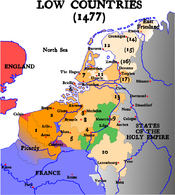
The Low Countries in 1477.
Neanderthal fossils were discovered at Engis and other places from 1829 to 1830, some dating back to 100,000 BP. Until the late Bronze Age, around 1750 BC, the population of Belgium was not very disperse. The Urnfields are believed to have arrived during the Bronze Age, and were followed by the possibly-related Hallstatts and La Tènes in the Iron Age. From 500 BC Celtic tribes settled in the region and began to trade with the Mediterranean. When Julius Caesar arrived in the region, the native inhabitants of Belgium were referred to as the Belgae (after whom the country is named), as recorded in De Bello Gallico. The Belgae and neighboring Treveri flourished within the Roman provinces of Gallica Belgica and Germania Inferior. Upon the collapse of the Western Roman Empire during the 5th and 6th centuries, Germanic tribes invaded and established themselves. One group of people, the Franks, settled in the area of Germania Inferior and eventually expanded to include all of Belgium and much of France, during the rule of the Merovingian Dynasty. However, the rule of the Merovingians was short-lived and power was later ceded to the Carolingian Dynasty, whose power base was located in the east of modern Belgium. King Charlemagne later brought a huge part of Europe under his rule and was crowned "Emperor of the new Holy Roman Empire" by Pope Leo III in Aachen circa 800. Frankish lands were divided and reunified between the Merovingians and Carolingians several times, but were eventually divided into France and the Holy Roman Empire. The portions of the County of Flanders stretching west of the river Scheldt became part of France, while the remainder of Flanders and the Low Countries were made part of the Holy Roman Empire. The territory of Belgium was eventually divided into relatively independent states, including the County of Flanders, the County of Namur, Duchy of Brabant, County of Hainaut, Duchy of Limburg, the County (later Duchy) of Luxembourg, and the Prince-Bishopric of Liège.
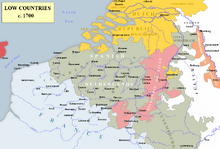
The Low Countries in 1700.
By 1433, most of the territory of Belgium and Luxembourg was annexed to the Duchy of Burgundy into the Burgundian Netherlands under Philip the Good (Philip III). When Mary of Burgundy, the granddaughter of Philip, married Holy Roman Emperor Maximilian I, the Low Countries became part of the Habsburg Empire. The Seventeen Provinces, known in its broad sense as the Habsburg Netherlands, was established with the promulgation of the Pragmatic Sanction of 1549 during the reign of Emperor Charles V, including portions of modern-day Belgium. After Charles V abdicated in 1556, his realms were divided between his son, Philip II of Spain, and his brother, Holy Roman Emperor Ferdinand I. The Seventeen Provinces were given to Philip, and were thereafter known as the Spanish Netherlands until the territory was ceded to Austria under the Treaty of Rastatt (1714), thus forming the Austrian Netherlands. As an act of rebellion against Emperor Joseph II, the United States of Belgium was established and later suppressed in 1790.
The lands of Belgium and Luxembourg were annexed to the French Republic in 1795, and later, along with the Kingdom of Holland, became part of Napoleon's French Empire. After Napoleon's defeat at Waterloo in 1815 and his subsequent abdication, the major victorious powers decided at the Congress of Vienna to reunite the former Austrian Netherlands and the former Dutch Republic, thus forming the United Kingdom of the Netherlands, which was intended to serve as a buffer state against French invasions. The Kingdom of Belgium was declared as independent from the Netherlands in 1831, as a result of the Belgian Revolution, which was mainly caused by the treatment of the French-speaking Catholic Walloons and the dominance of the Dutch in the Netherlands. However, it was not until the Treaty of London was signed in 1839 when its independence was recognized.
As part of the Schlieffen Plan used by the German Empire during World War I, neutral Belgium and Luxembourg were invaded and later occupied. This action ultimately caused the United Kingdom to enter the war, as they were bound by the Treaty of London to protect Belgium in the event of a war. The occupation ended at the end of the war, but Belgium was again occupied and invaded by the German Wehrmacht in World War II. The nation was liberated by Allied forces, including armies from Canada, the United Kingdom, and the United States, beginning in late 1944 and ending in 1945. Belgium is currently a federal state, and has been since the Belgian Constitution was changed in 1993.
Colonial empire[]
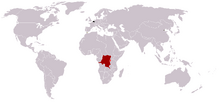
The Belgian colonial empire
The Kingdom of Belgium acquired its first "colony", the Congo Free State, during the reign of King Leopold II in 1885. Leopold exploited the area for its resources, and his regime often mutilated or killed villagers who did not fulfill their status quotas and distribute the appropriate amount of materials. In 1908, the Congo Free State was replaced with Belgian Congo in order to prevent an international outcry against the Belgian brutality towards the native peoples. Katanga, a territory held under the Congo Free State, was administered separately until 1910, when it was declared part of Congo. This new colony became independent from Belgium on June 30, 1960, and was later converted into the Republic of the Congo, a precursor to the current Democratic Republic of the Congo.
Ruanda-Urundi was part of German East Africa under military occupation from Belgium between 1916 and 1924, and later became a Belgian League of Nations mandate from 1924 to 1945, and a United Nations trust territory of the country until 1962, when it became the independent states of Burundi and Rwanda.
As a result of Boxer Rebellion, Belgium also acquired a concession in Tientsin, China. This was more of a trading post than a colony. It was under Belgian control from 1902 to 1931.
By decree of the Guatemalan parliament, the district of Santo Tomás was given "in perpetuity" to a company under protection of King Leopold I; however, efforts for colonizing the area ceased in 1854 due to the lack of finances and the climate. In homage to King Albert I, Isola Comacina was given by Italy to Belgium in 1919, but was returned the following year.
Economy[]

|
This page uses Creative Commons Licensed content from Wikipedia (view authors). |
- Main article: Economy of Belgium
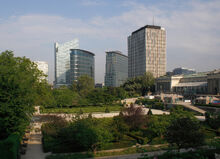
The financial district in Brussels
The strongly globalized economy and transport infrastructure of Belgium is united with the rest of Europe. Being located in the center of a highly industrialized region, Belgium was made the 15th largest trading in 2007. The economy is characterized by its highly productive work force, high gross national product, and high exports per capita. The country's main imports are chemicals, foodstuffs, raw diamonds, machinery and equipment, oil and petroleum, pharmaceuticals, raw materials, and transportation equipment. Its main exports are chemicals, finished diamonds, foodstuffs, machinery and equipment, metals, and metal products.
The economy of Belgium is oriented heavily on services and shows to have two natures: a Flemish economy and a Walloon economy, the latter of which slightly lags behind the other. The nation is one of the founding members of the European Union, and strongly supports an open economy and the extension of powers of the EU to link member economies. Belgium and its neighbor, Luxembourg, have been in an economic union since 1922, and are a single trade market with customs and currency unions.
In the 19th century, Belgium was the second nation in all of Europe, succeeded only by the United Kingdom, and the first nation in Continental Europe to undergo the Industrial Revolution. The cities of Liège and Charleroi quickly developed mining and steelmaking, which thrived until the middle of the 20th century in the Sambre and Meuse valley and made Belgium one of the three most industrialized nations in the world between 1830 and 1910. However, the textile industry in Flanders was in severe crisis by the 1840s, and the region experienced severe famine from 1846 to 1850.
Ghent and Antwerp rapidly expanded their chemical and petroleum industries after World War II ended. The oil crises of 1973 and 1979 sent the Belgian economy into a recession. This recession was particularly prolonged in the Wallonia region, where the steel industry seriously declined. The country's economic center moved northwards in the 1980s and 1990s, and is now concentrated in the Flemish Diamond area.
By the end of the 1980s, Belgian macroeconomic policies had resulted in a cumulative government debt of about 120% of GDP. As of 2006, the budget was balanced and public debt was equal to 90.30% of GDP. In 2005 and 2006, real GDP growth rates of 1.5% and 3.0%, respectively, were slightly above the average for the Euro area. Unemployment rates of 8.4% in 2005 and 8.2% in 2006 were close to the area average. By October 2010, this had grown to 8.5% compared to an average rate of 9.6% for the European Union as a whole (EU 27).
Despite a 18% decrease observed from 1970 to 1999, Belgium still had in 1999 the highest rail network density within the European Union with 113.8 km/1 000 km2. On the other hand, the same period of time, 1970–1999, has seen a huge growth (+56%) of the motorway network. In 1999, the density of km motorways per 1000 km2 and 1000 inhabitants amounted to 55.1 and 16.5 respectively and were significantly superior to the EU's means of 13.7 and 15.9. Belgium however experiences some of the most congested traffic in Europe. In 2010, commuters to the cities of Brussels and Antwerp spent respectively 65 and 64 hours a year in traffic jams. Like in most small European countries, more than 80% of the airways traffic is handled by a single airport, the Brussels Airport. The ports of Antwerp and Zeebrugge share more than 80% of Belgian maritime traffic, Antwerp being the second European harbor with a gross weight of goods handled of 115 988 000 t in 2000 after a growth of 10.9% over the preceding five years.
Numismatics[]
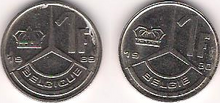
Franc coins with French (left) and Dutch (right) inscriptions
The numismatic history of Belgium is, like that of many European countries, fairly extensive. The Nervii tribe is credited for producing the first Belgian coins between 150 and 50 BC, and other Celtic tribes of the area later began to follow. Roman and Frankish coins were later issued in Belgium, and a number of mints were established in the territory beginning during the reign of Louis the Pious (814-840). The numerous states and cities in and around Belgium produced their own coinage systems in the Middle Ages. However, a unified currency system was established during the regnancy of Duke of Burgundy Philip the Good (1419-1467), which was based on the gros, equal to 12 deniers or 24 mites. A new system of coinage was introduced in 1612, during the reign of King Philip II of Spain. This system was primarily based on the sovereign d'or and the sol. When the Southern Netherlands were passed to the Austrian Habsburgs in 1714, a new currency system was soon adopted. Rebel coin issues of the United States of Belgium were later minted in 1790 at Brussels, as an act of opposing the Holy Roman Emperor. Such coins are listed in Krause's Standard Catalog of World Coins 1701-1800 under a section entitled "AUSTRIAN NETHERLANDS". Belgium began using the French franc after its territory was annexed to France in 1795. The franc was issued in Belgium until the territory became a part of the United Kingdom of the Netherlands in 1815, and the Dutch gulden became its official currency. As a sovereign nation, Belgium continued to use the gulden until it adopted its own currency, the Belgian franc, in 1832. While a majority of the earlier Belgian franc coins and banknotes only carried Dutch inscriptions and words, later coin issues began to accommodate for French speakers in addition to Dutch speakers, and banknotes started becoming trilingual, featuring words in Dutch, French, and German. During the period from 1944 to 2002, francs from Luxembourg were also used in Belgium, but were not as widely accepted in the country as its own currency was. The Belgian and Luxembourgish francs were rendered obsolete in 1999 upon the introduction of the euro, the current currency of both Belgium and Luxembourg. The Royal Mint of Belgium in Brussels is at present one of the many European institutions responsible for the production of euro coinage, and has been since 1998.
| Code | Currency Name | Dates | Conversion | Divisions | |||
|---|---|---|---|---|---|---|---|
| FRF | French franc |
|
10 Decimes = 100 Centimes = 1 Franc | ||||
| NLG | Dutch gulden |
|
100 Cents = 1 Gulden | ||||
| BEF | Belgian franc |
|
100 Centimes = 1 Franc | ||||
| EUR | Euro |
|
1 EUR = 40.3399 BEF | 100 Cents = 1 Euro |
See also[]
- Ghent
- Kelmis (La Calamine)
- Neutral Moresnet
References[]
Template:Belgium
| Europe | |
|---|---|
| Countries | Albania • Andorra • Armenia* • Austria • Azerbaijan* • Belarus • Belgium • Bosnia and Herzegovina • Bulgaria • Croatia • Cyprus* • Czech Republic • Denmark • Estonia • Finland • France • Georgia* • Germany • Greece • Hungary • Iceland • Ireland • Italy • Kazakhstan* • Latvia • Liechtenstein • Lithuania • Luxembourg • Macedonia • Malta • Moldova • Monaco • Montenegro • Netherlands • Norway • Poland • Portugal • Romania • Russia* • San Marino • Serbia • Slovakia • Slovenia • Spain • Sweden • Switzerland • Turkey* • Ukraine • United Kingdom • Vatican City |
| De facto countries | Abkhazia* • Kosovo • Nagorno-Karabakh* • Northern Cyprus* • South Ossetia* • Transnistria |
| Dependencies | Åland • Faroe Islands • Gibraltar • Guernsey • Isle of Man • Jersey • Republika Srpska • Svalbard and Jan Mayen |

